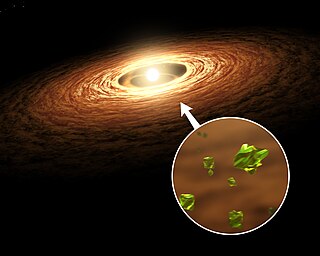| Observation data Epoch J2000.0 Equinox J2000.0 | |
|---|---|
| Constellation | Lupus |
| Right ascension | 16h 03m 05.491s[1] |
| Declination | −40° 18′ 25.43″[1] |
| Characteristics | |
| Evolutionary stage | Pre-main-sequence[2] |
| Spectral type | M0[3] |
| Variable type | YY Ori[4] |
| Astrometry | |
| Radial velocity (Rv) | −0.9±0.1[2] km/s |
| Proper motion (μ) | RA: −10.157 mas/yr[1] Dec.: −22.531 mas/yr[1] |
| Parallax (π) | 6.4634 ± 0.0150 mas[1] |
| Distance | 505 ± 1 ly (154.7 ± 0.4 pc) |
| Details | |
| Mass | 0.6[2] M☉ |
| Radius | 1.6[2] R☉ |
| Luminosity | 1.23±0.53[3] L☉ |
| Temperature | 3,850±177[3] K |
| Rotational velocity (v sin i) | 4.4±2.0[5] km/s |
| Other designations | |
| Database references | |
| SIMBAD | data |
EX Lupi is a young, single[2] T-Tauri star in the southern constellation of Lupus. An irregular variable,[8] it is the prototype of young, low-mass eruptive stars named EXors,[2] with EX Lupi being this object's variable star designation. At its minimal activity level, EX Lupi resembles a classical T-Tauri star of the M0 dwarf type.[9] The low latitude of this star, at a declination of −40°, makes it difficult for northern observers to view.[9] Based on parallax measurements, it is located at a distance of about 505 light years from the Sun.[1] The star lies next to a gap in the Lupus cloud complex, a star forming region.[10]
During 1944, Edith M. Janssen at Harvard Observatory noticed a stellar spectrum that displayed bright lines on a photographic plate taken April 11, 1929, but these lines were missing on a spectrum from July 13, 1928. This star was found to be only two magnitudes fainter than at maximum, so a nova was ruled out. D. B. McLaughlin then undertook a study of this object going as far back as 1893, finding further outbursts in 1901, 1914, 1925, 1929, 1934. Each time the brightness increased by about two magnitudes, followed by smaller, irregular fluctuations lasting 1–2 years before returning to a near constant minimum at magnitude 13.2.[7] Now designated EX Lupi, George Herbig studied the spectrum of this irregular variable in 1950, finding that it is similar to other emission-line stars associated with nebulosity.[11]
The next observed outburst was during the period 1955–1957 and was tracked by A. F. Jones. It reached a peak magnitude of 8.4, followed by a secondary brightening about 300 days later.[9] After a period of quiescence during the 1980s, another eruptive burst was observed in March 1994.[8] It reached a peak magnitude of 11.5 on both April 30 and May 14.[9] The cause was now understood to be the result of a mass accretion event with the infalling matter releasing its kinetic energy on the T-Tauri star. This creates a hot emission region that dominates the light output from the star. Many of the emission lines show an inverse P Cygni profile, thereby demonstrating that it is coming from infalling material. Absorption lines in the spectrum show a redshift indicating a velocity of 300 km/s.[8]

A major outburst of EX Lupi began in January 2008,[13] and it reached a peak visual magnitude of 8 during February.[14] It remained optically brighter by five magnitudes for a period of seven months.[15] Infrared observations of the star's circumstellar disk during the outburst shows spectral features of crystalline silicates, including strong indications of forsterite. The features resembled those seen in comets and some protoplanetary disks. The temperature of the disk is mostly below 700 K, indicating a circumstellar dust-free inner hole with a radius of 0.2 AU.[14] The disk may extend outward to at least 150 AU. At stellar quiescence, the infrared silicate feature at a wavelength of 10 μm can be explained as amorphous silicates of olivine and pyroxene.[2]
Matter from the circumstellar disk is being accreted onto the star by means of accretion columns.[5] This column may be the cause of the 7.417 day radial velocity variations observed with this star. EX Lupi is accreting mass at a typical estimated rate of 3.6×10−8 M☉·yr−1, which can climb as high as 10−7 M☉·yr−1 during peak bursts.[3] Between outbursts, the star undergoes moderate variability of 1–2 magnitudes due to variations in the rate of accretion.[5]
- ^ a b c d e Cite error: The named reference
GaiaEDR3was invoked but never defined (see the help page). - ^ a b c d e f g Cite error: The named reference
Sipos_et_al_2009was invoked but never defined (see the help page). - ^ a b c d Cite error: The named reference
Alcalá_et_al_2017was invoked but never defined (see the help page). - ^ Cite error: The named reference
Samus_et_al_2017was invoked but never defined (see the help page). - ^ a b c Cite error: The named reference
Sicilia-Aguilar_et_al_2015was invoked but never defined (see the help page). - ^ Cite error: The named reference
SIMBADwas invoked but never defined (see the help page). - ^ a b Cite error: The named reference
McLaughlin1946was invoked but never defined (see the help page). - ^ a b c Cite error: The named reference
Lehmann_et_al_1995was invoked but never defined (see the help page). - ^ a b c d Cite error: The named reference
Herbig_et_al_2001was invoked but never defined (see the help page). - ^ Cite error: The named reference
Herbig2007was invoked but never defined (see the help page). - ^ Cite error: The named reference
Herbig1950was invoked but never defined (see the help page). - ^ Cite error: The named reference
aavsowas invoked but never defined (see the help page). - ^ Cite error: The named reference
Jones2008was invoked but never defined (see the help page). - ^ a b Cite error: The named reference
Ábrahám_et_al_2009was invoked but never defined (see the help page). - ^ Cite error: The named reference
Aspin_et_al_2010was invoked but never defined (see the help page).
